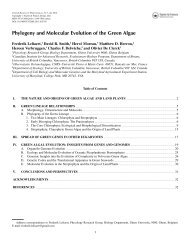Phylogeny and molecular evolution of green algae - Phycology ...
Phylogeny and molecular evolution of green algae - Phycology ...
Phylogeny and molecular evolution of green algae - Phycology ...
You also want an ePaper? Increase the reach of your titles
YUMPU automatically turns print PDFs into web optimized ePapers that Google loves.
8 CHAPTER 1<br />
smallest nuclear genome <strong>of</strong> all photosynthetic eukaryotes (Derelle et al. 2006) <strong>and</strong> Nephroselmis<br />
(Nephroselmidales) a small unicellular flagellate.<br />
Trebouxiophyceae - The Trebouxiophyceae mainly consist <strong>of</strong> freshwater (e.g. Chlorella) <strong>and</strong><br />
terrestrial <strong>algae</strong> (e.g. the phycobiont Trebouxia in lichens), some members (e.g. Prasiola) occur in<br />
marginally marine habitats. In contrast to most trebouxiophytes, the genus Prototheca is colorless<br />
<strong>and</strong> obligately heterotrophic <strong>and</strong> mainly lives in soil, but there are also some disease causing species.<br />
The enigmatic parasitic alga Helicosporidium is closely related to Prototheca (Tartar et al. 2002).<br />
Trebouxiophyceae occur as non-flagellate unicells or colonies, unbranched or branched filaments, or<br />
small blades (e.g. Prasiola) similar to those found among Ulvophyceae. Trebouxiophyceae commonly<br />
produce asexual, non-motile autospores. Sexual reproduction, involving flagellate sperm <strong>and</strong> nonmotile<br />
eggs, is only known for some representatives (e.g. Prasiola).<br />
The Trebouxiophyceae are characterized by a combination <strong>of</strong> ultrastructural characteristics: counterclockwise<br />
orientation <strong>of</strong> the basal bodies (Fig. 4), non-persistent metacentric mitotic spindles (Fig.<br />
5B) <strong>and</strong> the presence <strong>of</strong> a phycoplast (Fig. 5A), none <strong>of</strong> which is unique to the class. The basal body<br />
orientation is shared with the Ulvophyceae, metacentric spindles with the prasinophytes <strong>and</strong> nonpersistent<br />
spindles <strong>and</strong> phycoplasts with the Chlorophyceae. The monophyly <strong>of</strong> the<br />
Trebouxiophyceae has still to be proven due to the lack <strong>of</strong> unique structural or reproductive features<br />
<strong>and</strong> the failure <strong>of</strong> <strong>molecular</strong> phylogenetic studies to support monophyly (Krienitz et al. 2003, Lewis<br />
<strong>and</strong> McCourt 2004).<br />
Chlorophyceae - The Chlorophyceae mainly contain freshwater <strong>and</strong> terrestrial <strong>green</strong> <strong>algae</strong>. The class<br />
exhibits all major body plans found among <strong>green</strong> <strong>algae</strong>: unicells (flagellates <strong>and</strong> non-flagellates),<br />
sarcinoid organisms which are composed <strong>of</strong> packets <strong>of</strong> non-motile cells, colonies, unbranched or<br />
branched filaments <strong>and</strong> some multinucleate organisms. Asexual reproduction <strong>of</strong>ten occurs by means<br />
<strong>of</strong> flagellated zoospores but can also occur with non-motile aplanospores or autospores. Sexual<br />
reproduction may be isogamous, involving gametes that are morphological identical; anisogamous, in<br />
which case flagellate gametes are structurally distinguishable; or oogamous, with a large non-motile<br />
egg <strong>and</strong> smaller flagellate sperm. When sexual reproduction is present, Chlorophyceae always have a<br />
haploid vegetative phase <strong>and</strong> a single celled, <strong>of</strong>ten dormant, zygote as diploid stage (zygotic meiosis).<br />
Cell division is fairly uniform among Chlorophyceae <strong>and</strong> includes closed mitosis <strong>and</strong> a non-persitent<br />
mitotic spindle which collapses before cytokinesis. Cleavage is mostly mediated by a phycoplast but<br />
some Chlorophyceae divide by simple centripetal furrowing <strong>of</strong> the cell wall. The production <strong>of</strong> a cell<br />
plate that develops centrifugally by fusion <strong>of</strong> Golgi-derived vesicles in which case plasmodesmata or<br />
channels through the cell wall will allow intercellular communication after division have been<br />
reported for Cylindrocapsa <strong>and</strong> Uronema (see chapter 7 <strong>and</strong> van den Hoek et al. 1995, Graham et al.<br />
2009).<br />
The monophyly <strong>of</strong> the Chlorophyceae is corroborated by the presence <strong>of</strong> clockwise or direct opposite<br />
flagellar root supports (Fig. 4). The two major clades are formed by the Chlamydomonadales<br />
(clockwise basal body orientation) which include genera like Chlamydomonas <strong>and</strong> Volvox <strong>and</strong> the

















